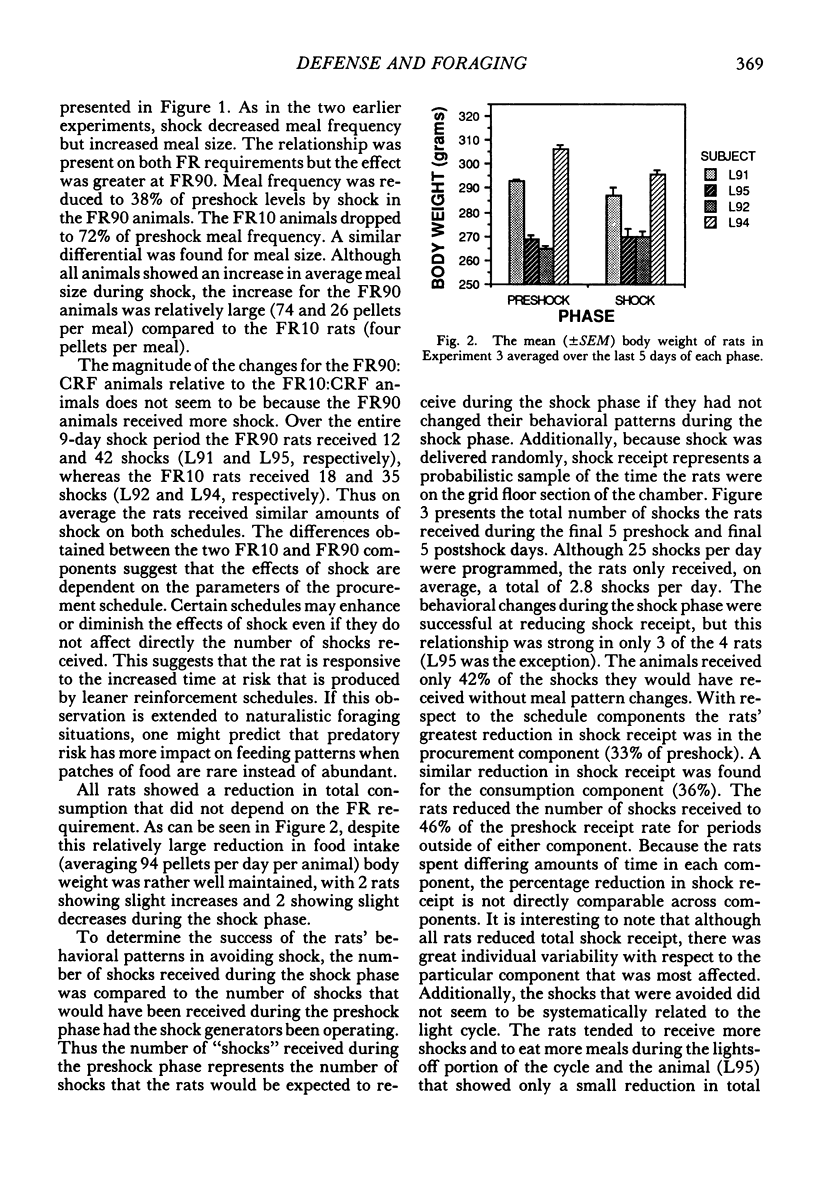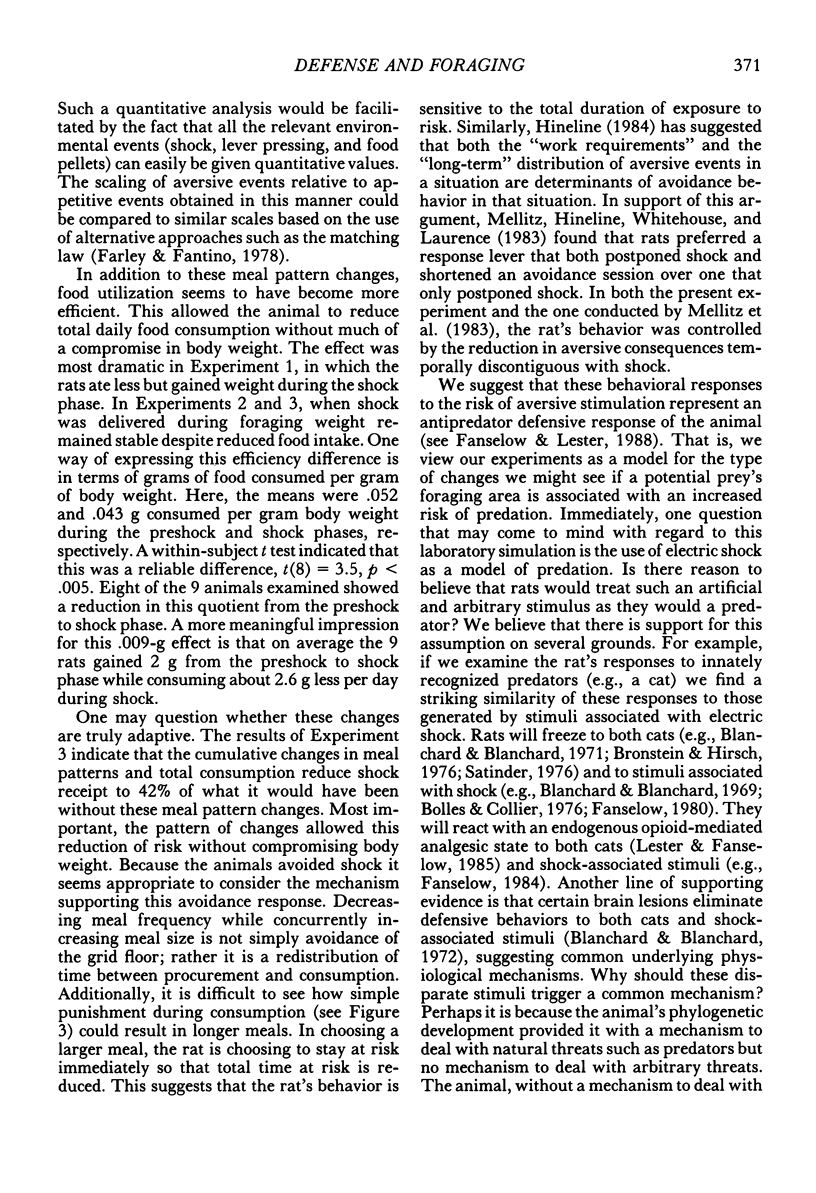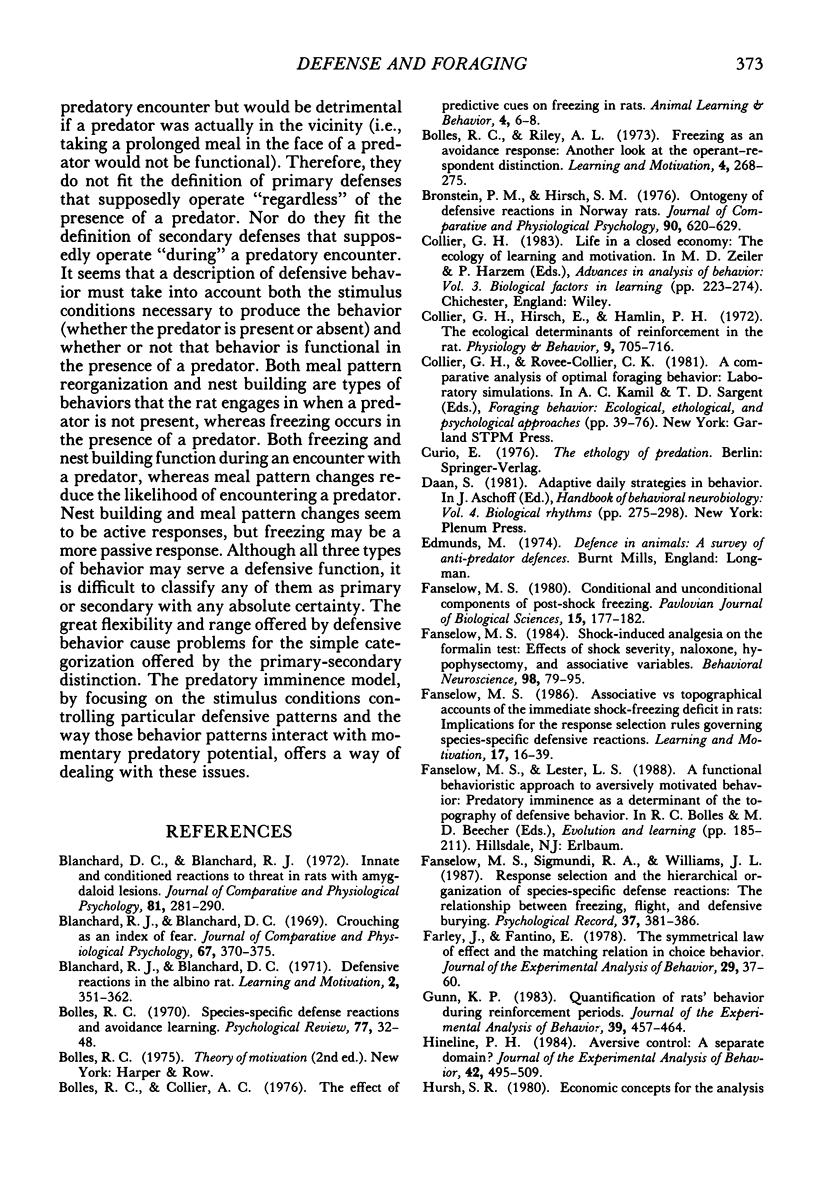Abstract
The effects of the risk of electric shock on the meal patterns of rats living in an operant chamber were investigated. Rats could obtain food by working on a response lever that provided reinforcement according to chained fixed-ratio continuous reinforcement schedules that allowed the animals control over meal size. Using a two-compartment operant chamber with a safe nesting area and manipulanda area with a grid floor, shock could be correlated with responding on the schedule. Shocks (less than or equal to 1.25 per hour) were scheduled to occur randomly throughout the day, independent of the rat's behavior. Shock caused a reorganization of meal patterns such that the animals took less frequent but larger meals. This pattern reduced the time the animals spent at risk without compromising caloric balance. Similar changes in feeding pattern were obtained in both hooded and albino rats. Exposure to shock in a separate chamber did not produce these behavioral modifications. The magnitude of shock-induced alterations of meal patterns was greater with chained fixed-ratio 90 continuous reinforcement than with chained fixed-ratio 10 continuous reinforcement. Additionally, the rats seemed to be able to reduce food intake but increase caloric efficiency, such that the reduced food intake did not have deleterious effects on maintenance of body weight. These behavioral modifications reduced the number of shocks received from that which would have been expected if meal pattern changes had not occurred. We suggest that this technique may provide a useful laboratory simulation of the impact that the risk of predation has on foraging behavior.
Full text
PDF













Selected References
These references are in PubMed. This may not be the complete list of references from this article.
- Blanchard D. C., Blanchard R. J. Innate and conditioned reactions to threat in rats with amygdaloid lesions. J Comp Physiol Psychol. 1972 Nov;81(2):281–290. doi: 10.1037/h0033521. [DOI] [PubMed] [Google Scholar]
- Blanchard R. J., Blanchard D. C. Crouching as an index of fear. J Comp Physiol Psychol. 1969 Mar;67(3):370–375. doi: 10.1037/h0026779. [DOI] [PubMed] [Google Scholar]
- Bronstein P. M., Hirsch S. M. Ontogeny of defensive reactions in Norway rats. J Comp Physiol Psychol. 1976 Jul;90(7):620–629. doi: 10.1037/h0077224. [DOI] [PubMed] [Google Scholar]
- Collier G., Hirsch E., Hamlin P. H. The ecological determinants of reinforcement in the rat. Physiol Behav. 1972 Nov-Dec;9(5):705–716. doi: 10.1016/0031-9384(72)90038-8. [DOI] [PubMed] [Google Scholar]
- Fanselow M. S. Conditioned and unconditional components of post-shock freezing. Pavlov J Biol Sci. 1980 Oct-Dec;15(4):177–182. doi: 10.1007/BF03001163. [DOI] [PubMed] [Google Scholar]
- Fanselow M. S. Shock-induced analgesia on the formalin test: effects of shock severity, naloxone, hypophysectomy, and associative variables. Behav Neurosci. 1984 Feb;98(1):79–95. doi: 10.1037//0735-7044.98.1.79. [DOI] [PubMed] [Google Scholar]
- Farley J., Fantino E. The symmetrical law of effect and the matching relation in choice behavior. J Exp Anal Behav. 1978 Jan;29(1):37–60. doi: 10.1901/jeab.1978.29-37. [DOI] [PMC free article] [PubMed] [Google Scholar]
- Gunn K. P. Quantification of rats' behavior during reinforcement periods. J Exp Anal Behav. 1983 May;39(3):457–464. doi: 10.1901/jeab.1983.39-457. [DOI] [PMC free article] [PubMed] [Google Scholar]
- Hineline P. N. Aversive control: A separate domain? J Exp Anal Behav. 1984 Nov;42(3):495–509. doi: 10.1901/jeab.1984.42-495. [DOI] [PMC free article] [PubMed] [Google Scholar]
- Hursh S. R. Behavioral economics. J Exp Anal Behav. 1984 Nov;42(3):435–452. doi: 10.1901/jeab.1984.42-435. [DOI] [PMC free article] [PubMed] [Google Scholar]
- Hursh S. R. Economic concepts for the analysis of behavior. J Exp Anal Behav. 1980 Sep;34(2):219–238. doi: 10.1901/jeab.1980.34-219. [DOI] [PMC free article] [PubMed] [Google Scholar]
- Lester L. S., Fanselow M. S. Exposure to a cat produces opioid analgesia in rats. Behav Neurosci. 1985 Aug;99(4):756–759. doi: 10.1037//0735-7044.99.4.756. [DOI] [PubMed] [Google Scholar]
- Mellitz M., Hineline P. N., Whitehouse W. G., Laurence M. T. Duration-reduction of avoidance sessions as negative reinforcement. J Exp Anal Behav. 1983 Jul;40(1):57–67. doi: 10.1901/jeab.1983.40-57. [DOI] [PMC free article] [PubMed] [Google Scholar]
- SOLOMON R. L., KAMIN L. J., WYNNE L. C. Traumatic avoidance learning: the outcomes of several extinction procedures with dogs. J Abnorm Psychol. 1953 Apr;48(2):291–302. doi: 10.1037/h0058943. [DOI] [PubMed] [Google Scholar]
- Satinder K. P. Reactions of selectively bred strains of rats to a cat. Anim Learn Behav. 1976 May;4(2):172–176. doi: 10.3758/bf03214030. [DOI] [PubMed] [Google Scholar]
- Timberlake W., Peden B. F. On the distinction between open and closed economies. J Exp Anal Behav. 1987 Jul;48(1):35–60. doi: 10.1901/jeab.1987.48-35. [DOI] [PMC free article] [PubMed] [Google Scholar]


